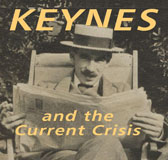The General Theory and the Current Crisis: A Primer on Keynes’ Economics
Intro | Pt. I | Pt. II | Pt. III | Pt. IV
Part III: Keynes, Wage and Price “Stickiness,” and Deflation
This article is from the September/October 2009 issue of Dollars & Sense: Real World Economics available at http://www.dollarsandsense.org

This is a web-only article, available only at www.dollarsandsense.org.
Subscribe Now
at a 30% discount.

Most people are accustomed to worrying about inflation, which has been a durable fact of life in the United States for half a century. The overall price level in the U.S. economy (a sort of average of prices across the economy), as measured by the Consumer Price Index, has increased every calendar year since 1957. Or, rather, had increased every year since 1957, until 2008. Last year, as the U.S. economy went into its most severe recession since the Great Depression, the CPI declined by 0.2%. For the first time in decades, there is reason in the United States to worry about the dangers of deflation.
Lower prices may sound appealing, but deflation can make a bad recession worse. Deflation can bring down overall demand. If individuals and firms expect prices to decline, they may postpone purchases. Why buy today, if the price will be lower tomorrow? Declining prices and wages can exacerbate firms’ negative expectations about future sales and profits, discouraging current investment. If a firm does not think it will be able to sell future output at a sufficient profit, it will not make purchases of new plant and equipment now. Deflation can also make the cost of borrowing higher, and increase the burden of past debt. This can ruin debtors and bankrupt firms, as each dollar owed becomes harder to come by as prices drop. Over the three years with the sharpest drop in output and employment during the Great Depression, 1930-1933, the Consumer Price Index dropped by over 25%. More broadly, a study by economists Michael Bruno and William Easterly of over 100 countries from the 1960s to 1990s showed that rates of deflation between 0% and 20% were associated with lower rates of economic growth than low to moderate rates of inflation (up to 30%) were.
Such concerns about deflation run sharply counter to the “mainstream” or neoclassical view of recessions. Neoclassical economists argue that the economy is “self-correcting,” and that if it dips into recession it will quickly return itself to “full employment” without any need for deliberate government action. One of their main arguments for this view is that prices—including wages (the price of labor) and interest rates (the price of money)—are flexible. If there is excess supply of labor (unemployment), workers will reduce their wage demands, causing employers to want to hire more labor and workers to offer less labor for sale, until the surplus is eliminated. Likewise, if there is excess saving, the interest rate will decline, causing people to save less and borrow more, until that surplus is eliminated. In this view, a recovery (from a period of low employment and output) involves a decrease in the price level. Deflation, in other words, is the cure for what ails us.
One response to the neoclassical argument is that, in fact, prices are not perfectly flexible (they exhibit “stickiness”). For this reason, the economy is not self-correcting, at least not in the short run. Wages and prices may be “too high” (and, therefore, result in suppliers offering larger quantities for sale than demanders are able and willing to buy), but not come down quickly and eliminate the market surplus. This view has been widely attributed to John Maynard Keynes, and is, in fact, a key argument in what is known as “New Keynesian” economic theory. But this was not Keynes’ argument.
Keynes expressed, in numerous passages in The General Theory, the view that wages were “sticky” in terms of money. He noted, for example, that workers and unions tended to fight tooth-and-nail against any attempts by employers to reduce money wages (the actual sum of money workers receive, as opposed to the real purchasing power of these wages, taking account of changes in the cost of living), even by a little bit, in a way they did not fight for increases in wages every time there was a small rise in the cost of living eroding their “real wages.” Keynes argued emphatically, however, against the idea that the stickiness of money wages was the cause of unemployment, or that full flexibility of money wages (in particular, a decline in money wages) was likely to be a cure for depressions.
Keynes was careful to describe many different possible effects of declining money wages, some pointing towards increased consumption or investment (and therefore an increase in total output and incomes), and some pointing in the opposite direction. He pointed out two fundamental errors in the conventional view that lower money wages would necessarily result in increased employment. First, he noted that, while one worker could gain employment (at the expense of someone else) by accepting a lower wage, this did not automatically mean that lower money wages across the board would cause overall employment to increase. Second, he argued that, while decreased money wages would result in increased employment if total (“aggregate”) demand were unchanged, there was no reason to believe that would be the case.
Keynes made at least four major arguments that declining money wages were not the cure for unemployment (and depressions) that classical economists thought.
1) Workers do not decide their level of real wages, and so cannot reduce these to a level that will ensure full employment. Keynes pointed out that particular workers (or groups of workers) and employers bargained not over real wages, but money wages. Real wages depended not only on these money-wage bargains but also on the overall price level. The price level, in turn, depended on money-wage bargains made between many different groups of workers and employers across the economy as a whole. Keynes argued that, if workers in general were to accept lower money wages, the overall price level could not possibly remain unchanged. The price level, instead, would decline by a similar proportion, so real wages might not change very much at all. In that case, employers would not have an incentive to hire more workers, and overall employment would change very little.
2) Reductions in workers’ money wages may result in decreased consumption, and therefore can result in lower incomes and output. Keynes argued that declines in money wages change the distribution of income—increasing the incomes of owners of other factors of production (capitalists and landowners) at the expense of workers, and those of rentiers (owners of money capital) at the expense of entrepreneurs (owners of businesses). These changes in distribution could result in a decrease in the “marginal propensity to consume” (the amount spent on consumption out of each additional dollar of income). Declining money wages (and the resulting decline in the price level) would tend to redistribute income from lower-income individuals (who tend to consume a very large proportion of their incomes) to higher-income individuals (who tend to consume lower proportions of their incomes, and to save higher proportions).
3) Declining wages can create incentives for employers to postpone purchases of durable equipment. Keynes argued that the effects of the reduction in money wages on the incentive for capitalists to invest (purchase durable equipment) depended on the expectations of future changes in money wages. If money wages declined, but capitalists expected them to go up in the immediate future (that is, money wages were thought to have “bottomed out”), Keynes argued, the effect on investment would be positive, since the cost of producing durable equipment now would be lower than in the future. However, if the decline in money wages made capitalists expect continued future declines, the effect on investment would be negative. Durable equipment purchased in the current period would, in Keynes’ words, have to “compete … with the output from equipment produced [in the future] … at a lower labor cost.” Owners of the more expensive equipment would have to cut their prices and accept lower profits to match the prices that owners of the less expensive equipment would be willing to accept (having the advantage of lower costs). This would produce an incentive to put off purchases of such equipment into the future.
4) A decline in the price level creates increased real burdens for debtors. When the price level goes down, the purchasing power of the currency increases. We would say, “A dollar becomes more valuable.” Since most debts take the form of a specific sum of money owed, and the real purchasing power of this sum increases as the price level decreases, the real purchasing power that the debtor has to hand over also increase. Looked at another way, across-the-board deflation means that the debtor cannot charge as much for whatever she sells, but the amount of money she has to pay to the creditor does not change. Therefore, she now has to sell more units (of whatever it is she sells) to pay back the debt. Debt service will swallow up an increasing proportion of her gross income. “If the fall of wages and prices goes far … those entrepreneurs who are heavily indebted,” Keynes argues, “may soon reach the point of insolvency.” That is, deflation can result in an epidemic of bankruptcies.
Keynes’ arguments on the effects of declining wages and prices during a recession were part of his case, contrary to the mainstream economics of his time (and ours), that capitalist economies were not inherently “self-correcting.” Depression conditions, Keynes argued, would not necessarily set off a chain of events pulling the economy back to its “full employment” level of output. Declining money wages and prices could, in fact, lead to a downward spiral deeper into recession. Capitalist economies could get stuck in a low-output, high-unemployment condition. Keynes believed that government action was necessary to guarantee a return to and maintenance of full employment. For this reason, he argued that the complacent attitude of conventional economists toward economic crises—that, eventually, the problem would solve itself—was not of much use. “Economists set them too easy, too useless a task,” he wrote, “if in tempestuous seasons they can only tell us that when the storm is over the ocean is flat again.”
Did you find this article useful? Please consider supporting our work by donating or subscribing.
